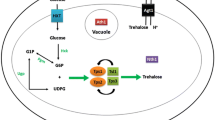Abstract.
The disaccharide trehalose is widely distributed in nature and can be found in many organisms, including bacteria, fungi, plants, invertebrates and mammals. Due to its particular physical features, trehalose is able to protect the integrity of the cell against a variety of environmental injuries and nutritional limitations. In addition, data available on several species of bacteria and yeast suggest specific functions for trehalose in these organisms. Bacteria can use exogenous trehalose as the sole source of carbon and energy as well as synthesize enormous amounts of the disaccharide as compatible solute. This ability to accumulate trehalose is the result of an elaborate genetic system, which is regulated by osmolarity. Some mycobacteria contain sterified trehalose as a structural component of the cell wall, whereas yeast cells are largely unable to grow on trehalose as carbon source. In these lower eukaryotes, trehalose appears to play a dual function: as a reserve compound, mainly stored in vegetative resting cells and reproductive structures, and as a stress metabolite. Recent findings also point to important biotechnological applications for trehalose.
Similar content being viewed by others
Author information
Authors and Affiliations
Additional information
Electronic Publication
Rights and permissions
About this article
Cite this article
Argüelles, J. Physiological roles of trehalose in bacteria and yeasts: a comparative analysis. Arch Microbiol 174, 217–224 (2000). https://doi.org/10.1007/s002030000192
Received:
Revised:
Accepted:
Issue Date:
DOI: https://doi.org/10.1007/s002030000192




